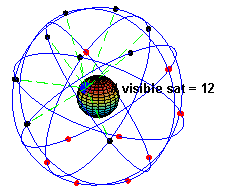The hardware in the sky that makes the Global Positioning System work is a mystery to most of us. You, however, will soon know a lot more about it.
After all, why wouldn’t you want to know more about the system that makes all of today’s cool location-based services possible? GPS has become our everyman, everyday companion now that it’s present in just about every smartphone out there.
So here you go, more interesting GPS factoids than you can shake a stick at:
- There are always at least 24 active GPS satellites circling Earth, although today there are more than 30, including a couple of spares. Their orbits are spread out so that no matter where on Earth you are, you will have at least six of them in your line of sight.
- Each GPS satellite goes around the world once every 12 hours. The satellites travel 12,500 miles (20,000 km) above us at roughly 7,000 miles per hour (11,000 km per hour). They have small boosters so they can adjust their path when needed.
- The first full constellation of 24 satellites was completed in 1994. The first of those 24 satellites was sent up in 1989.
- To get a reliable position reading, your GPS receiver will have to combine the signals from at least four satellites, although in some special cases, three are enough.
- GPS was made public due to a tragedy. In 1983, Korean Air Lines Flight 007 entered Soviet airspace after a navigation error and was shot down, killing all 269 passengers. This incident resulted in President Ronald Reagan ordering the Unites States military to make the Global Positioning System available for civilian use once it was completed, so that similar incidents could be avoided in the future.
- NAVSTAR is the US military name for the Global Positioning System.
- GPS isn’t just for navigation. It can also be used to get a very exact time stamp. Every GPS satellite has multiple atomic clocks and the time is included in the signal it sends out. With the help of these signals, a GPS receiver can determine the current time within 100 billionths of a second. These signals are for example used to synchronize base stations in cell phone networks.
- Relativistic effects. The clocks on the satellites, although very exact, are still subject to the effects of Einstein’s theory of relativity, which means that the time of the clocks in the satellites will slowly start to deviate from those on Earth. This is adjusted by control signals from Earth.
- Ground antennas spread around the world are used to control the satellites’ paths and synchronize their clocks.
- The 50th Space Wing of the United States Air Force operates the GPS satellites. GPS is owned by and is under the control of the United States Department of Defense.
- Until 2000, civilian GPS use was crippled by a feature called Selective Availability. It introduced a random error of up to 328 feet (100 meters) in the civilian signal to make GPS less useful for precision navigation. (GPS has different signals for military and civilian use.) Selective Availability was deactivated in May 1, 2000. The United States still has the ability to deactivate the civilian signal, if need be even for specific regions.
- During the Gulf War in 1991, many US soldiers were equipped with civilian GPS units due to a shortage of military ones. However, Selective Availability made it extremely difficult to properly coordinate troop movements with civilian GPS units, so it was turned off for the duration of the war.
- GPS is a work in progress. The system is continuously being upgraded and new satellites are being launched. This all means that precision will keep getting better, which will make the system increasingly useful.
- GPS isn’t the only game in town. There are several other Global Navigation Satellite Systems in existence or on their way: The European Union is working on a system called Galileo, Russia has GLONASS (completed in partnership with India), and China has plans for a system called Compass. There are also systems that offer specific regional coverage, for example Japan’s QZSS and China’s Beidou.
- The beginning: Satellite navigation systems date back to 1960. That was when Transit, used by the United States Navy, was first tested successfully. Transit used up to 10 satellites, and receivers judged their position based on the Doppler effect on the signals sent out from the satellites. Modern systems like GPS work differently, relying heavily on exact timing, hence the use of atomic clocks in the GPS satellites.
Geeky? Yes, but you know us… Pingdom is full of geeks. 😉
Did we miss some really cool or interesting factoid about GPS? Please let us know in the comments.
Oh, and one last thing. Here is an animation showing how a constellation of 24 GPS satellites are spread out and and how many are visible at once:

Data sources: Wikipedia and the US Government GPS portal.
Image sources: NASA (the GPS satellite image) and Wikipedia (the satellite animation).




























